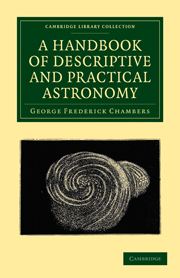Book contents
- Frontmatter
- PREFACE
- SUPPLEMENT
- Contents
- LIST OF ILLUSTRATIONS
- PRINCIPAL AUTHORITIES
- Errata
- A Handbook of Descriptive and Practical Astronomy
- BOOK I A SKETCH OF THE SOLAR SYSTEM
- BOOK II ECLIPSES AND THEIR ASSOCIATED PHENOMENA
- BOOK X METEORIC ASTRONOMY
- CHAPTER I
- CHAPTER II
- CHAPTER III
- APPENDICES
- INDEX TO SUBJECTS
- INDEX TO NAMES
- Plate section
- Frontmatter
- PREFACE
- SUPPLEMENT
- Contents
- LIST OF ILLUSTRATIONS
- PRINCIPAL AUTHORITIES
- Errata
- A Handbook of Descriptive and Practical Astronomy
- BOOK I A SKETCH OF THE SOLAR SYSTEM
- BOOK II ECLIPSES AND THEIR ASSOCIATED PHENOMENA
- BOOK X METEORIC ASTRONOMY
- CHAPTER I
- CHAPTER II
- CHAPTER III
- APPENDICES
- INDEX TO SUBJECTS
- INDEX TO NAMES
- Plate section
Summary
To account for the nature and origin of aerolites, the following hypotheses have been propounded: —
First.—It is supposed that the matter composing them has been drawn up from the surface of the Earth in a state of infinitely minute subdivisions, as vapour is drawn from liquids; that, being collected in clouds in the higher regions of the atmosphere, it is there agglomerated and consolidated in masses, and falls by its gravity to the surface of the Earth; being occasionally drawn from the vertical direction which would be imparted to it by gravity by the effect of atmospheric currents, and thus occasionally striking the Earth obliquely. We shall call this the atmospheric hypothesis.
Secondly.—It is supposed that meteoric stones are ejected from volcanoes, with sufficient force to carry them to great elevations in the atmosphere, in falling from which they acquire the velocity and force with which they strike the Earth. The oblique direction with which they strike the ground is explained by the supposition that they may be projected from the volcanoes at corresponding obliquities, and that, by the principles of projectiles, they must strike the Earth at nearly the same inclination as that with which they have been ejected. This we shall call the volcanic hypothesis.
- Type
- Chapter
- Information
- A Handbook of Descriptive and Practical Astronomy , pp. 399 - 402Publisher: Cambridge University PressPrint publication year: 2010First published in: 1861



